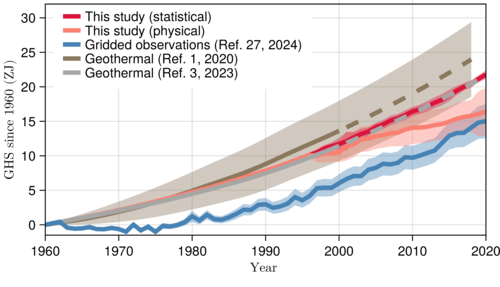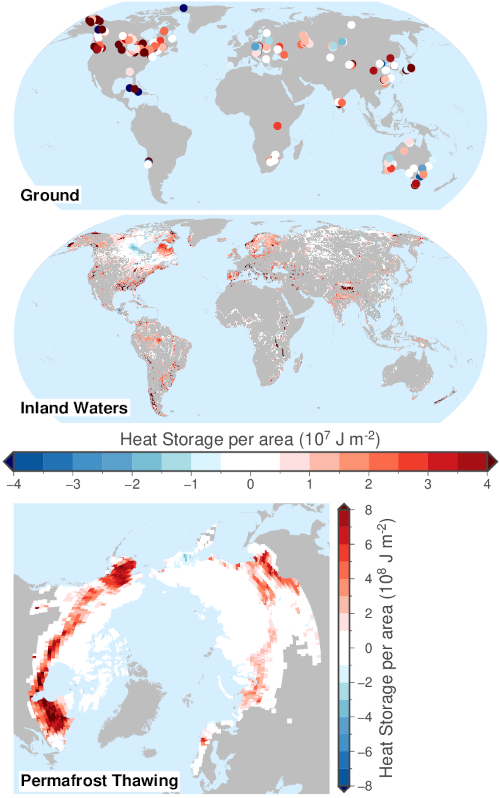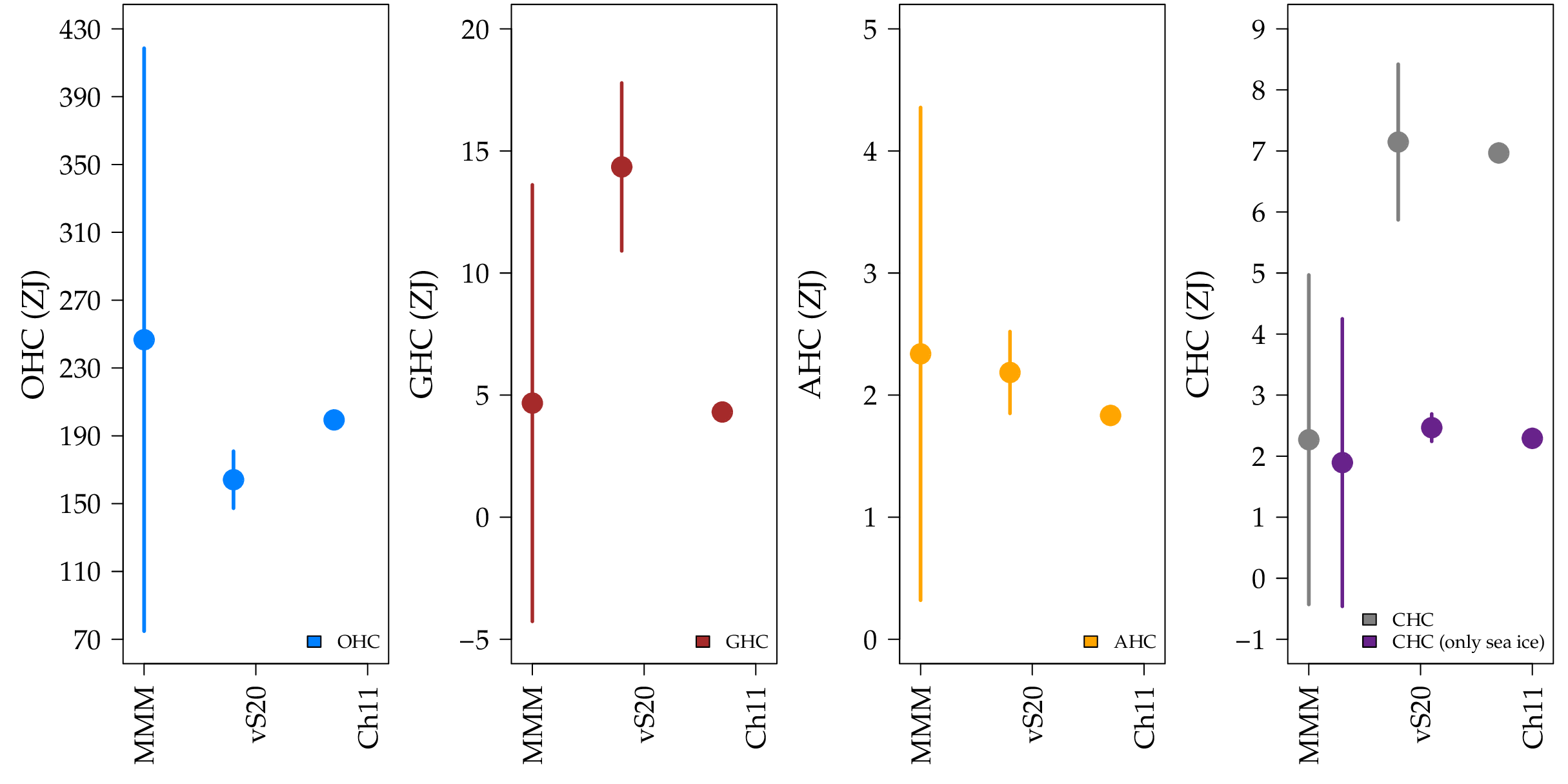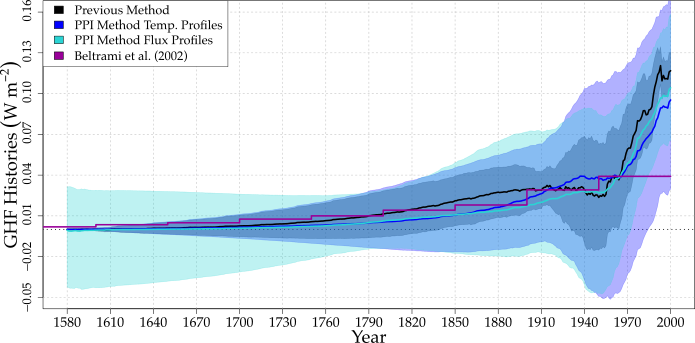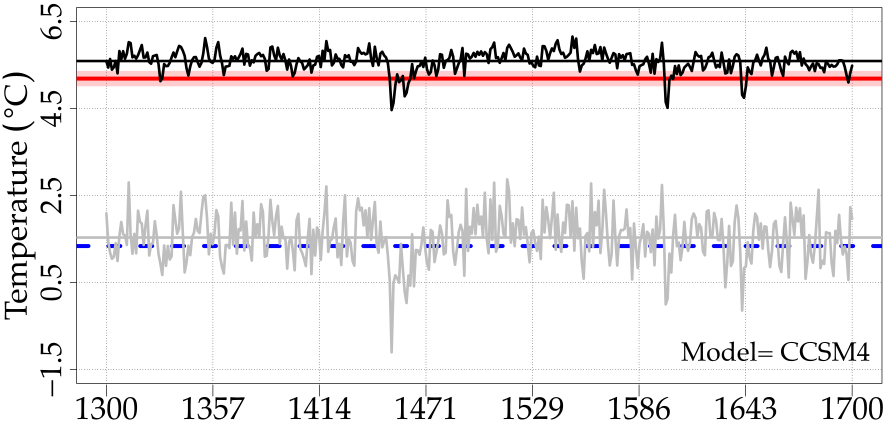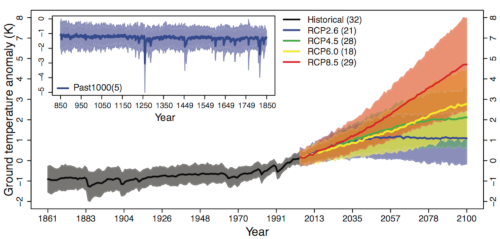Highlighted Researth
Robust increase in observed heat storage by the global subsurface
The Earth heat inventory is a fundamental measure of ongoing climate change, and ground heat storage (GHS) is its second-largest term, storing approximately 5-6% of the total heat gained by our planet. Monitoring the GHS evolution is crucial because of the associated warming of the shallow subsurface, which can trigger permafrost thawing, activating the permafrost carbon feedback and hindering efforts to achieve the Paris Agreement temperature targets. Furthermore, subsurface warming influences physical processes critical to society and ecosystems, such as intensifying extreme heat events under dry soil conditions, and altering soil microbial communities. Prior to this work, there was a significant lack of data to accurately estimate global GHS after the year 2000.
To overcome data limitations and provide a continuous estimate, satellite remote sensing data was used to expand and update traditional estimates from geothermal data for the period 1960-2020. Reconciling the historical geothermal data with the modern satellite data was challenging due to the differences in temporal resolution and coverage. Therefore, a physical and a statistical method were used to reconcile satellite and geothermal estimates.
The global GHS experienced a substantial heat gain between \(\mathrm{16.4\pm 3.4\ ZJ}\) and \(\mathrm{21.78\pm 0.62\ ZJ}\) over the last six decades (1960-2020). Crucially, the global ground heat storage shows a positive acceleration ranging from \(\mathrm{0.16\pm 0.15\ ZJ\, dec^{-2}}\) to \(\mathrm{0.624\pm 0.032\ ZJ\, dec^{-2}}\). This finding reveals that the rate of heat accumulation in the land subsurface is increasing, mirroring the acceleration observed in the other major components of the climate system, such as the temperature of the surface, or the sea-level rise.
Furthermore, the new method combining geothermal and satellite estimates derived here ensures the future monitoring of GHS, providing essential data for climate modeling and mitigation efforts.
Reference:
Cuesta-Valero, F. J., García-García, A., Beltrami, H., Garcí-Pereira, F., González-Rouco, J. F., and Peng, J.(2025). Robust increase in observed heat storage by the global subsurface. Science Advances, https://doi.org/10.1126/sciadv.adw9958.
Data:
Cuesta-Valero, F. J. (2025). Robust increase in observed heat storage by the global subsurface: Ground heat storage estimates (1.0.0) [Data set]. Zenodo. https://doi.org/10.5281/zenodo.17339736.
Continental heat storage: Contributions from ground, inland waters, and permafrost thawing
Changes in many natural systems and processes can now be perceived by humans as result of climate change, such as the retreat of glaciers in mountains around the world, or the increase in the intensity, duration, and frequency of extreme temperature events. All of these indicators are directly or indirectly related to changes in heat storage and distribution. Greenhouse gases tend to alter the energy fluxes at the top of the atmosphere, causing the heating of the climate system that constitutes the so called greenhouse effect. This additional heat is then distributed among the oceans, the atmosphere, the cryosphere and the continental surface and subsurface, changing the energy balance between the components of the climate system. The determination of this Earth heat inventory is the best metric to quantify climate change, a number telling us the energy used to alter the behavior of the Earth's climate components.
Changes of heat-dependent processes near the continental surface are particularly relevant as the vast majority of human activities and many natural services happen near the surface of the planet, such as agriculture or freshwater storage. The heat going into the land is used mostly to warm the ground. The warming of perennially frozen soil in the Arctic, also known as permafrost soils, and its eventual thawing, is of particular importance for determining future climate change. Arctic soils are rich in organic matter that remains inert as long as temperature is below the freezing point. However, microbial decomposition activates when this organic matter thaws, generating significant amounts of carbon dioxide and methane that are eventually released into the atmosphere, constituting a feedback mechanism that amplifies the increase in surface temperatures. Furthermore, natural and artificial water bodies, such as lakes and rivers, also receive additional heat, resulting in the warming of their waters. Warmer waters change the habitability zones for certain species of fish and algae, altering entire ecosystems. Therefore, it is important to quantify and monitor the amount of extra heat absorbed by the land surface and subsurface, in order to understand and predict how natural processes altered by heat storage will affect human societies in the near and long-term future.
Despite the relevance for quantifying heat storage in the land subsurface, permafrost soils and inland water bodies, there was no comprehensive study assessing the three components of continental heat storage at the same time. In this paper, an international collaboration of geoscientists has assessed the available evidence of changes in heat content in the land subsurface, permafrost soils, and inland water bodies to quantify the total continental heat storage during the last sixty years. The assessment finds a global increase in continental heat storage in the three analyzed components of the land surface and subsurface. The land subsurface stores ~90% of the heat due to its larger surface in comparison with permafrost (10 times more surface) and inland water bodies (100 times more surface), followed by permafrost soils storing ~9% of heat and inland water bodies storing the remaining ~1% of heat. These results indicate that continental heat storage is increasing globaly, and thus we should expect impacts on human activities in the near future.
Reference:
Cuesta-Valero, F. J., Beltrami, H., García-García, A., Krinner, G., Langer, M., MacDougall, A. H., Nitzbon, J., Peng, J., von Schuckmann, K., Seneviratne, S. I., Thiery, W., Vanderkelen, I., and Wu, T. (2023). Continental heat storage: Contributions from ground, inland waters, and permafrost thawing. Earth Syst. Dynam., 14, 609-627, https://doi.org/10.5194/esd-14-609-2023.
Press release (Eng), Press release (Ger)
Data:
Cuesta-Valero, F. J. , Beltrami, H., García-García, A., Krinner, G., Langer, M., MacDougall, A., Nitzbon, J, Peng, J., von Schuckmann, K., Seneviratne, S.I., Thiery, W., Vanderkelen, I., Wu, T. (2023). GCOS EHI 1960-2020 Continental Heat Content (Version 2). World Data Center for Climate (WDCC) at DKRZ. https://doi.org/10.26050/WDCC/GCOS_EHI_1960-2020_CoHC_v2.
Boostrapping Inversions of Subsurface Temperature Profiles
Inversions of subsurface temperature profiles are the most important source of information about the evolution of continental heat storage, allowing to estimate the changes in ground surface temperature and ground heat flux during the last centuries. This long-term estimates are useful to evaluate global climate simulations, helping us to understand the dynamics of the Earth system and increasing our confidence in future climate projections. Inversions of subsurface temperature profiles have also played an important role in the development of land surface model components, improving the simulated transfer of energy through the ground in numerical climate experiments.
The inversion techniques are based on estimating the quasi-equilibrium temperature profile of the subsurface, in order to retrieve the signature of recent changes in the surface energy balance on the temperature profile. The procedure typically consists in solving an overdetermined system of equations, in most cases using a Singular Value Decomposition (SVD) algorithm, which limits the temporal resolution of the retrieved surface temperature (or heat flux) evolution.
Although there are several SVD methods able to retrieve ground surface temperature and ground heat flux histories from individual subsurface temperature profiles, these techniques do not include a meaningful, interpretable framework for aggregating inversions from sets of different profiles. The most important caveat in these methods consists of determining the confidence interval for the averaged temperature and heat flux histories at the regional and global levels. In fact, those methodologies are wrong from a statistical point of view, and a new method based on solid statistical principles needs to be developed to provide correct, interpretable confidence intervals for the averaged histories from individual inversions of subsurface temperature profiles.
Here, we introduce a new statistical framework to improve estimates of uncertainty in ground surface temperature and ground heat flux histories from SVD inversions. This new method is based on a bootstrap technique to sample the uncertainty due to plausible values of poorly known inversion parameters that can be applied to any number of profiles. Our results reinforce the role of the inversions of subsurface temperature profiles as indicators of the long-term evolution of surface conditions.
Reference:
Cuesta-Valero, F. J., Beltrami, H., Gruber, S., García-García, A., and González-Rouco, J. F. (2022). A new bootstrap technique to quantify uncertainty in estimates of ground surface temperature and ground heat flux histories from geothermal data. Geosci. Model Dev., 15, 7913-7932, doi:10.5194/gmd-15-7913-2022.
Code:
Cuesta-Valero, F. J. (2022). CIBOR: Codes for Inverting BOReholes (Version 1.0.0). [Computer software]. https://doi.org/10.5281/zenodo.7017521.
Simulated Earth Heat Inventory in CMIP5 Simulations
Anthropogenic activities have caused a sustained energy imbalance at the top of the atmosphere. That is, the Earth absorbs more solar radiation than it radiates back into the Space as infrared radiation. As result, there is a heat storage within the different Earth's subsystems: the ocean, the atmosphere, the cryosphere, and the continental subsurface. Although the ocean accounts for around the 89% of the total heat storage, the heat storage within the rest of components is not negligible, since numerous processes relevant to the evolution of climate change depend on this redistribution of heat.
Many efforts have been dedicated to understand the changes in ocean heat content due to its large capacity to store energy and its importance for understanding climate change, but only in recent times there have been coordinated efforts to measure the entire Earth heat inventory. Furthermore, only a few studies have assessed the ability of global climate simulations to represent the different components of the Earth heat inventory.
This work analyzes the ability of advanced climate models to correctly represent the heat storage within each Earth reservoir during the last part of the 20th century. The model ensemble overestimates the ocean heat storage, and underestimates the heat content of the continental subsurface and the cryosphere. Most model simulations capture the change in atmosphere heat storage and the heat uptake by sea ice melting. Limiting the range of responses to the external forcing by the models is required to enhance the comparison with observations, particularly for evaluating ocean heat storage, while the development of a few, key aspects of the land surface model components could greatly improve the represented continental heat storage and the heat uptake by terrestrial ice masses.
Reference:
Cuesta-Valero, F.J., García-García, A., Beltrami, H., and Finnis, J. (2021). First Assessment of the Earth Heat Inventory Within CMIP5 Historical Simulations. Earth Syst. Dynam., 12, 581-600, doi:10.5194/esd-12-581-2021. Article highlighted by the editors of ESD.
Feeling the Heat: The Grilled Earth. Entry for the EGU blog: Climate: Past, Present & Future.
Global Ground Heat Content from Subsurface Temperature Profiles
Heat storage within the continental subsurface is the second largest term of the Earth's heat inventory, thus it is fundamental to understand the magnitude and evolution of the Earth's energy imbalance at the top of the atmosphere. Furthermore, several processes depending on subsurface heat fluxes are important to project future climate change, such as permafrost thawing or changes in soil respiration due to increasing soil temperature. Therefore, ascertaining the change in the continental heat storage has become urgent in recent years.
Nevertheless, meteorological stations do not provide with measurements of the subsurface thermal regime, thus estimates from subsurface temperature profiles are required. Previous studies were able to retrieve changes in continental heat storage during the second part of the last millennium, but the sources of uncertainty considered in those analyses were limited.
This work provides new global estimates of changes in ground surface temperature, ground surface heat flux, and continental heat storage derived from subsurface temperature profiles using an expanded database and new techniques to account for more sources of uncertainty. Our analysis reveals higher changes in ground heat flux and heat storage within the continental subsurface than previously reported, and it suggests that the Earth's surface has warmed around 0.7 K since preindustrial times.
Reference:
Cuesta-Valero F.J., García-García A., Beltrami H., González-Rouco J.F., and García-Bustamante E. (2021). Long-Term Global Ground Heat Flux and Continental Heat Storage from Geothermal Data. Clim. Past, doi:10.5194/cp-17-451-2021. Article highlighted by the editors of CP.
Data:
Cuesta-Valero, F. J., Beltrami, H., García-García, A., González-Rourco, J. F., García-Bustamante, E. (2021). Xibalbá: Underground Temperature Database. figshare. Dataset. https://doi.org/10.6084/m9.figshare.13516487.v4.
A Temperature Climatology for North America
The simulation of several physical processes governing the evolution of the climate system depends on the represented mean climate state. Particularly, positive feedbacks such as, the ice-albedo feedback, the water vapor feedback and the stability of permafrost are related to the simulated temperature climatology. These feedbacks also contribute to the estimate of equilibrium climate sensitivity within each model.
Although current global climate models are able to reproduce the evolution of the global surface temperature in comparison with observations, the simulated mean surface temperature climatology presents a wide range of values among models, as it is the case for the obtained equilibrium climate sensitivity.
In this work, we propose the use of long-term surface temperatures estimated from geothermal measurements as an additional tool to better evaluate the realism of surface temperature climatology within global preindustrial simulations, and, in turn, to help improve the representation of mean state-dependent feedbacks.
Reference:
Cuesta-Valero F.J., García-García A., Beltrami H., Zorita E. and Jaume-Santero F. (2019). Long-term Surface Temperature (LoST) database as a complement for GCM preindustrial simulations. Climate of the Past, 15, 1099-1111, doi:10.5194/cp-15-1099-2019.
Data:
Cuesta-Valero, F. J., García-García, A., Beltrami, H., Zorita, E., Jaume-Santero, F. (2019). Long-term Surface Temperature (LoST) Database. figshare. Dataset. https://doi.org/10.6084/m9.figshare.8124887.v1.
Continental Heat Storage from Global Simulations and Geothermal Data
The energy gained by the Earth's system due to the current radiative imbalance at top of the atmosphere is stored mostly within the ocean. Nonetheless, the heat storage in the continental subsurface is important for determining the distribution of the Earth's energy budget and the magnitude of the Earth's energy imbalance. Furthermore, several climate processes with potentially important climate feedback mechanisms take place in the shallow subsurface, and their stability and evolution are dependent on the long-term thermal state of the ground. Processes such as the stability of the soil carbon pool and the stability of large areas of permafrost require robust estimates of energy fluxes at the continental surface for proper long-term modeling of their conditions in a future climate.
In this work, we compare the simulated heat content within the continental subsurface from a large ensemble of CMIP5 simulations with observational estimates from geothermal data. Our analysis demonstrates the importance of the represented subsurface volume in the context of continental energy storage within global simulations, and further provides a framework for understanding possible sources of uncertainty in the simulation of subsurface energy content.
Reference:
Cuesta-Valero F.J., García-García A., Beltrami H. and Smerdon J.E. (2016). First Assessment of Continental Energy Storage in CMIP5 Simulations. Geophysical Research Letters, 43, doi:10.1002/2016GL068496.
Press Release


